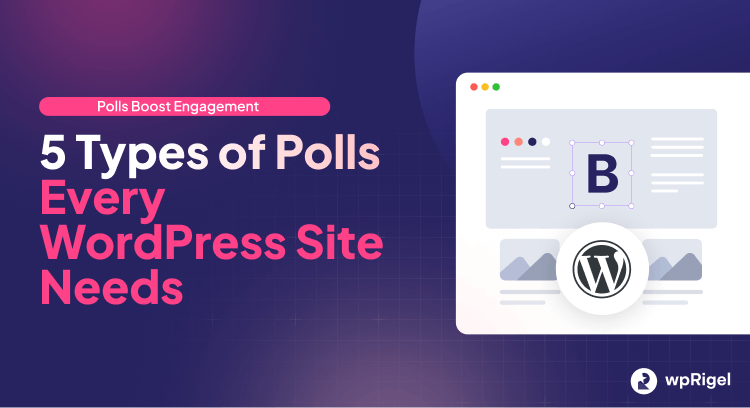
5 Types of Polls Every WordPress Site Needs
The average website visitor spends just 54 seconds on a page– unless you give them a reason to stay.
Think about it: You’ve spent hours crafting the perfect blog post, designing your homepage, or creating that killer landing page. But within less than a minute, most visitors are gone. Poof. Just like that.
The problem isn’t your content (well, maybe it is, but let’s assume it’s not). The real issue is that static content simply doesn’t cut it anymore. Your visitors want interaction, engagement, something that makes them feel involved rather than just… reading.
Here’s where strategic poll implementation comes in. I’m not talking about random “What’s your favorite color?” polls that add zero value. I’m talking about five specific types of polls that will transform passive visitors into engaged participants while giving you invaluable data about your audience.
Ready to turn those 54-second visits into meaningful interactions?
Let’s dive in.
Why Every WordPress Site Needs Multiple Poll Types
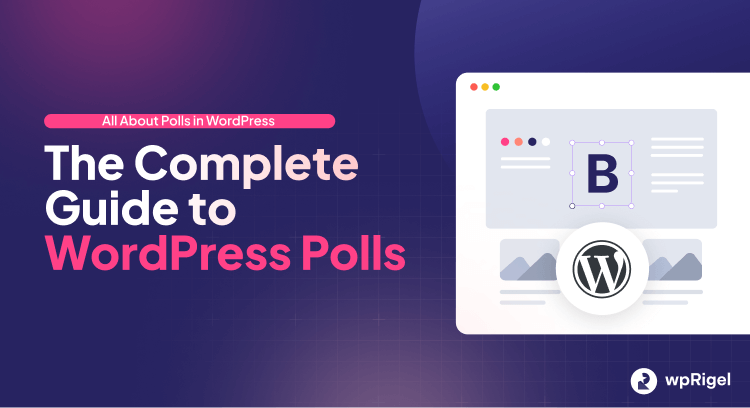
Before we jump into the specific poll types, let’s talk about why you need variety in your polling strategy. It’s like having different tools in a toolbox – you wouldn’t use a hammer for everything, right?
Audience Segmentation Made Simple
Different visitors come to your site with different intentions. Some are first-timers who need guidance, others are returning visitors looking for specific information, and some are ready-to-buy prospects who need that final push. Different poll types serve different visitor segments.
Content Lifecycle Strategy
Your content goes through various stages – from initial engagement to conversion and beyond. Each stage requires a different approach to maximize effectiveness. Welcome polls work great for new visitors, while feedback polls are perfect for post-purchase experiences.
Business Intelligence Collection
WordPress powers 43.1% of the internet, but most sites are flying blind when it comes to understanding their audience. Multiple poll types give you multiple data collection points, creating a comprehensive picture of your visitors’ needs, preferences, and behaviors.
SEO Benefits You Can’t Ignore
Interactive content increases dwell time, reduces bounce rates, and sends positive user signals to search engines. When someone engages with your poll, they’re spending more time on your page – and Google notices.
Here’s what the data tells us: Interactive content generates 2x more engagement than static content. Yet most WordPress sites stick to the same old blog post format and wonder why their engagement metrics are flatlining.
The solution? Strategic poll implementation that serves your business goals while providing genuine value to your visitors.
Poll Type 1: The Welcome Poll – Know Your Audience
This is your digital handshake – the first impression that sets the tone for everything that follows.
The welcome poll is designed for one purpose: first-time visitor segmentation and personalization. Think of it as your site’s concierge, greeting visitors and guiding them toward the most relevant content.
When to Use Welcome Polls
Your homepage is the obvious choice, but don’t stop there. Landing pages from paid campaigns, first-time blog visits, and even your about page can benefit from strategic welcome polls. The key is placing them where new visitors are most likely to land.
Question Examples That Actually Work
Instead of generic questions, try these proven approaches:
- What brought you here today?
- Looking for WordPress tutorials
- Need help with my existing site
- Researching plugins and tools
- Just browsing around
2. What’s your biggest challenge with [your topic]?
- Getting more traffic
- Converting visitors to customers
- Technical WordPress issues
- Creating engaging content
3. Which best describes you?
- Complete WordPress beginner
- I have some WordPress experience
- I’m a WordPress developer
- I run a WordPress agency
Welcome Poll Implementation Strategy: Entry Point Optimization
The magic isn’t just in the questions – it’s in what you do with the answers.
Based on their response, you can:
- Show personalized content recommendations
- Display relevant lead magnets
- Adjust your site’s messaging
- Track different user journeys
Success Metrics to Track
- Completion rate (aim for 60%+ for well-designed polls)
- Segmentation accuracy (how well responses predict actual behavior)
- Impact on bounce rate and session duration
Advanced Features That Make a Difference
Modern poll plugins like Pollify allow you to display different content based on poll answers. Imagine showing WordPress tutorials to beginners while displaying advanced development resources to experienced users – all automatically.
Here’s a ready-to-use template you can implement today:
Welcome Poll Template: “Help us personalize your experience – what describes you best?”
- I’m new to WordPress and need guidance
- I’m a WordPress user looking to improve my site
- I’m a developer or designer
- I run an agency and serve clients
- Just checking out what you offer
Real-World Impact of Welcome Poll
One site I analyzed saw a 34% increase in page views after implementing welcome polls. Why? Because they were showing the right content to the right people from the moment they arrived.
The key lesson: Don’t make visitors hunt for relevant content. Ask them what they need and give it to them.
Poll Type 2: The Feedback Poll – Improve Your Content
If welcome polls are your handshake, feedback polls are your ongoing conversation with your audience.
These polls serve one critical purpose: content optimization and audience satisfaction measurement. But here’s the thing – most people do feedback polls wrong.
Strategic Placement or Feedback Poll for Maximum Response
Timing is everything with feedback polls. Place them at the end of blog articles (but before comments), after course modules, or on product pages where people have had time to consume your content.
The worst place? Pop-ups that interrupt reading. Don’t be that site.
Question Framework for Feedback Poll That Gets Honest Answers
“Was this helpful?” (with a follow-up for context) If yes: “What was most valuable?” If no: “What were you hoping to find instead?”
“What would you like to see more of?”
- More detailed tutorials
- Video explanations
- Real-world examples
- Tool recommendations
“Rate this content” (1-5 scale with specific criteria) Instead of just “Rate this post,” try “How well did this solve your problem?” or “How likely are you to recommend this to a colleague?”
Immediate Action Strategy for Feedback Poll
Here’s where most sites fail: They collect feedback and do nothing with it. The magic happens when you act on feedback immediately and publicly.
Got feedback that your tutorial was missing screenshots? Add them and mention in your next email that you updated the content based on reader feedback. This builds trust and shows you’re listening.
Long-term Content Strategy
Use feedback data to plan future content. If 70% of readers want more video explanations, guess what your next content priority should be?
Implementation Examples
Blog Post Integration: At the end of tutorials: “Did this solve your problem? What else would you like to know?”
Product Page Feedback: “How confident do you feel about using this plugin after reading this review?”
Course Content: “What part of this lesson was most challenging?”
Pro Tips for Better Response Rates on Feedback Poll
- Time your requests wisely – Don’t ask for feedback before someone has had time to consume your content
- Incentivize honest feedback – Offer a small bonus like a checklist or template
- Show that you act on feedback – Publicly mention improvements made based on user input
- Keep it short – One question is often better than five
The goal isn’t just to collect feedback – it’s to create a feedback loop that continuously improves your content while building stronger relationships with your audience.
Poll Type 3: The Decision Poll – Guide Your Visitors
Ever watched someone stand frozen in the cereal aisle, overwhelmed by choices? That’s what happens to your website visitors when you give them too many options without guidance.
Decision polls solve this by helping visitors navigate options while collecting valuable preference data.
Use Cases for The Decision Poll That Actually Matter
Product Comparison Assistance: “Which matters most for your next WordPress plugin?”
- Easy setup and user-friendly interface
- Advanced features and customization
- Strong customer support
- Budget-friendly pricing
Content Recommendation Engine: “What’s your experience level with WordPress?” Then show beginner tutorials or advanced guides accordingly.
Service Selection Guidance: “What’s your biggest priority right now?”
- Increasing website traffic
- Improving conversion rates
- Technical site improvements
- Content creation help
The Psychology of Decision Poll: Reducing Choice Paralysis
When faced with multiple options, people often choose nothing. Decision polls work because they:
- Break complex decisions into simple questions
- Provide personalized recommendations
- Make visitors feel guided rather than overwhelmed
- Create a sense of progress toward their goal
Business Value: Understanding Customer Priorities
But here’s the hidden benefit: You’re not just helping visitors – you’re collecting data about what matters most to your audience. This informs everything from product development to marketing messaging.
Technical Implementation: Dynamic Results
Modern poll plugins allow you to show different results based on answers. Someone who prioritizes “budget-friendly” options sees different recommendations than someone focused on “advanced features.”
Real-World Applications of The Decision Poll
E-commerce Example: “Which feature matters most in your next WordPress theme?”
- Mobile responsiveness
- Page speed optimization
- SEO-friendly structure
- Design flexibility
- E-commerce integration
Based on their answer, show themes that excel in their priority area.
Service Business Example: “What’s your timeline for this project?”
- I need help immediately
- Within the next month
- I’m planning for next quarter
- Just researching options
This helps qualify leads while providing appropriate next steps.
Content Website Example: “What type of content helps you learn best?”
- Step-by-step written tutorials
- Video walkthroughs
- Interactive examples
- Downloadable templates
Then customize your content recommendations accordingly.
Advanced Strategies for Decision Poll Types
Progressive Disclosure: Start with broad questions, then get more specific based on answers. This prevents overwhelming visitors while gathering detailed information.
Personalized Recommendations: Use poll data to create custom landing pages or email sequences for different visitor segments.
Lead Scoring Integration: Assign different point values to answers to identify high-intent prospects automatically.
The key is making visitors feel like you understand their specific situation and can provide relevant solutions.
Poll Type 4: The Trend Poll – Tap Into Current Events
Want to create content that gets shared, discussed, and brings new visitors to your site? Trend polls are your secret weapon.
These polls leverage trending topics for viral engagement and social sharing while establishing your site as a thought leader in your niche.
Timing Strategy for The Trend Poll: Newsjacking Done Right
The key to successful trend polls is timing. You need to be early enough to catch the wave but not so early that people don’t understand what you’re talking about.
Monitor industry news, social media conversations, and Google Trends. When you spot something gaining momentum, create a poll around it within 24-48 hours.
Question Design for The Trend Poll: Controversial But Professional
The best trend polls take a stance or ask about divisive topics – but in a professional, thoughtful way.
Avoid: “Is AI stupid or amazing?” Try: “Which AI impact concerns you most as a content creator?”
- Job displacement fears
- Quality control challenges
- Ethical considerations
- Learning curve difficulties
Viral Mechanics: Shareable Results
Design your polls so the results themselves are worth sharing. Include surprising insights, counterintuitive findings, or data that challenges common assumptions.
Community Building: Discussion Starters
Great trend polls don’t just collect votes – they spark conversations. Encourage comments by asking follow-up questions or sharing your own perspective on the results.
Examples of The Trend Poll by Industry
WordPress/Tech: “Which WordPress trend will have the biggest impact in 2025?”
- AI integration in content creation
- Headless WordPress adoption
- Enhanced security measures
- Mobile-first design evolution
Digital Marketing: “What’s the future of email marketing?”
- AI-powered personalization will dominate
- Privacy laws will limit effectiveness
- Video emails will become standard
- It’ll remain mostly unchanged
General Business: “Remote work in 2025: What’s your prediction?”
- Full return to office
- Hybrid will be the norm
- Fully remote becomes standard
- It depends on the industry
The Trend Poll: Distribution Strategy for Maximum Reach
Social Media Optimization: Create shareable graphics with poll questions and results. Twitter/X, LinkedIn, and Instagram all love interactive content.
Influencer Engagement: Share your poll with industry influencers and ask for their take. Many will share interesting polls with their audience.
Community Forum Sharing: Post in relevant Facebook groups, Reddit communities, or industry forums (following their rules, of course).
Measuring Success
Track not just poll participation but:
- Social shares and mentions
- New visitors from social traffic
- Comments and discussion quality
- Follow-up content engagement
The goal isn’t just viral content – it’s building authority and bringing new people into your ecosystem.
Poll Type 5: The Exit Intent Poll – Recover Lost Visitors

Here’s a sobering truth: Most visitors will leave your site without taking any action. But before they go, you have one last chance to engage users.
Exit intent polls are your final opportunity to convert departing visitors into subscribers, customers, or at least gather valuable data about why they’re leaving.
Technical Setup: Exit Intent Detection
Modern poll plugins can detect when someone is about to leave (mouse movement toward the browser’s close button, scrolling to the bottom, or inactivity). The key is timing – too early and you’re annoying, too late and they’re gone.
Question Strategy for The Exit Intent Poll: Quick, Valuable, Non-Pushy
Exit intent polls need to be fast and valuable. People are already leaving, so you have seconds to grab their attention with something worthwhile.
Avoid: “Wait! Don’t go! Subscribe to our newsletter!” Try: “Before you go, quick question: What were you hoping to find today?”
Recovery Tactics: Address Common Objections
Use exit poll data to understand why people leave, then address those issues proactively on your site.
Common departure reasons:
- Couldn’t find specific information
- Content wasn’t detailed enough
- Looking for different pricing/options
- Site was too slow or confusing
- Found what they needed elsewhere
Data Collection: Understanding Departure Reasons
This data is gold for improving your site. If 40% of people say they were “looking for pricing information,” maybe you need clearer pricing pages or better navigation.
Question Examples That Work for The Exit Intent Poll
“Before you go, what were you looking for?”
- Specific tutorial or guide
- Product information
- Pricing details
- Contact information
- Something else (please specify)
“What would bring you back to this site?”
- More detailed tutorials
- Better search functionality
- Regular email updates
- Exclusive offers or content
“Quick question: Why didn’t you [take action]?” (customize based on your goal)
- Didn’t find what I needed
- Want to research more options
- Price isn’t right for me
- Not ready to make a decision
Integration Opportunities for The Exit Intent Poll
Email Capture with Value: “Couldn’t find what you needed? Join our weekly newsletter and be first to know when we publish new guides.”
Content Recommendation: Based on what they were looking for, suggest specific articles or resources.
Problem-Solving Resource: “Sounds like you’re dealing with [specific problem]. Here’s a free checklist that might help.”
Success Metrics
- Recovery rate (percentage who engage with exit poll)
- Conversion from exit poll to desired action
- Quality of feedback received
- Improvement in site metrics after implementing suggestions
The key is viewing exit intent polls not as desperate last attempts, but as valuable feedback tools that help you improve the experience for future visitors.
Implementation Roadmap for WordPress Poll: Getting Started
Now that you understand the five poll types, here’s how to roll them out systematically without overwhelming yourself or your visitors.
Week-by-Week Rollout Strategy
Week 1: Welcome Poll on Homepage
Start with your highest-traffic page. Install your chosen poll plugin and create a simple welcome poll. Focus on getting the technical setup right and measuring initial response rates.
Week 2: Feedback Polls on Top Content
Identify your 5 most popular blog posts or pages. Add feedback polls to the bottom of each. Start collecting data about content effectiveness.
Week 3: Decision Polls on Key Pages
Add decision polls to your most important conversion pages – pricing pages, service pages, or product comparisons. Help visitors navigate their options.
Week 4: First Trend Poll for Social Engagement
Create your first trend poll around a current industry topic. Focus on making it shareable and driving discussion.
Week 5: Exit Intent Polls on High-Traffic Pages
Implement exit intent polls on pages with high bounce rates or where you’re losing potential conversions.
Success Tracking Framework
Don’t just implement and forget. Track these metrics for each poll type:
Universal Metrics:
- Participation rates by poll type
- Completion rates and drop-off points
- Impact on overall engagement time
- Correlation with conversion goals
Poll-Specific KPIs:
- Welcome polls: How well do responses predict actual behavior?
- Feedback polls: What percentage of feedback gets implemented?
- Decision polls: Do recommendations match final user choices?
- Trend polls: Social sharing rates and discussion quality
- Exit polls: Recovery success rate and feedback actionability
Avoiding Poll Fatigue
Here’s a critical mistake to avoid: Don’t show multiple polls to the same visitor in the same session. Use your poll plugin’s logic to ensure someone who completes a welcome poll doesn’t also see an exit intent poll.
Set frequency caps and use cookies to track poll interactions across visits.
Roll Your Poll Creation Out Faster with Pollify Poll Maker Plugin
Pollify makes the week-by-week plan ridiculously simple because every poll type you outlined—welcome, feedback, decision, trend, and exit intent—exists as a native Gutenberg block. Drop the block, tweak copy and styling, set display rules, and publish. No shortcodes, no external dashboards, no duct tape. That means Week 1 isn’t “learn a new tool,” it’s “ship your first poll in minutes.”
As you expand to Weeks 2–5, Pollify’s targeting and frequency controls keep things respectful. Show a welcome poll only once per session, exclude people who’ve already interacted, and trigger exit polls only on specific pages with high bounce. Because results live in your WordPress dashboard, you can review response rates after a day, adjust wording, and redeploy without breaking flow.
The real win is iteration speed. Need a variation for mobile users? Duplicate the block and tweak. Want to test a new decision question on your pricing page? Swap it in and watch the real-time chart update. You can explore all these features on the Pollify feature page or see upgrade options on the pricing page. If you need help setting things up, our Pollify documentation has you covered.
Technical Considerations for WordPress Implementation
Let’s get practical about the technical side of implementing polls on your WordPress site.
Plugin Requirements That Matter
Gutenberg-Native Integration: Your poll plugin should work seamlessly with WordPress’s block editor. Look for plugins that offer dedicated Gutenberg blocks rather than just shortcodes.
Mobile Responsiveness: Over 409 million people view WordPress.com-built sites every month, and many of them are on mobile devices. Your polls must work perfectly on all screen sizes.
Loading Speed Optimization: Polls should enhance engagement, not slow down your site. Choose plugins that load resources efficiently and offer caching compatibility.
Analytics Integration: Look for plugins that integrate with Google Analytics or provide their own detailed reporting. You need data to optimize your polling strategy.
Best Practices for Performance
Database Optimization: Poll data can accumulate quickly. Choose plugins that optimize database queries and offer data cleanup options for old polls.
Caching Considerations: If you use caching plugins (and you should), ensure your poll plugin is compatible. Some poll features like real-time results may conflict with aggressive caching.
Security and Spam Prevention: Implement CAPTCHA for polls that accept text responses. Set rate limits to prevent spam voting. Consider requiring registration for sensitive polls.
GDPR Compliance: If you collect personal data through polls, ensure compliance with privacy regulations. Many modern plugins handle this automatically, but verify the features.
Recommended Technical Setup
- Choose a reputable poll plugin with good support and regular updates
- Test poll functionality across different devices and browsers
- Set up proper analytics tracking for poll interactions
- Configure spam prevention and rate limiting
- Create a poll archive or results page for transparency
- Implement proper schema markup for SEO benefits
Meet the Technical Bar with Pollify—Natively
Your technical checklist maps directly to how Pollify is built. It’s 100% Gutenberg-native, so polls inherit your theme styles, load minimal assets, and play nicely with caching. No third-party iframes, no extra DNS lookups, no mystery scripts. The result: better Core Web Vitals and fewer surprises across devices.
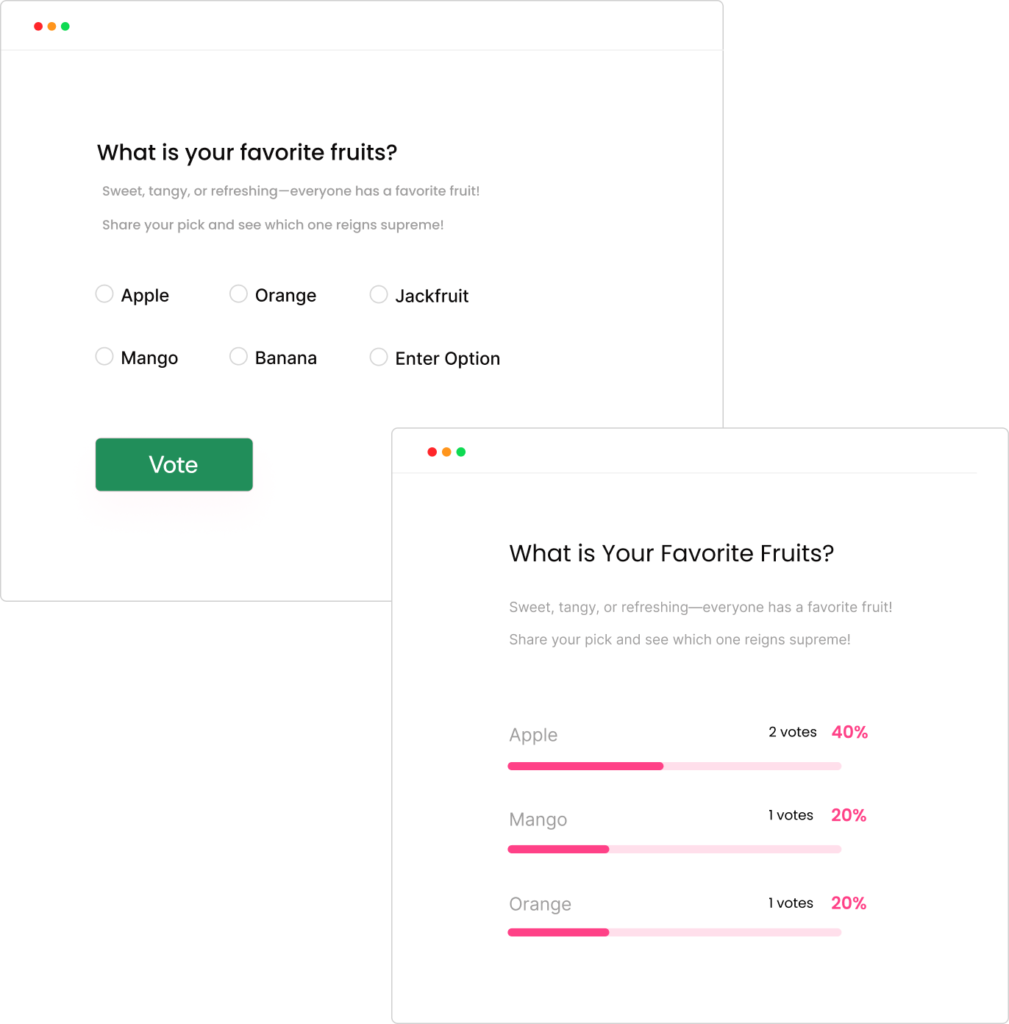
On the data side, Pollify stores responses locally in WordPress, giving you control for privacy and compliance. IP controls, vote limits, and optional anonymous mode reduce spam while keeping results clean. If you accept text feedback, add CAPTCHA and rate limits in a couple of clicks. Using a performance stack? Pollify works smoothly alongside popular caching and security plugins.
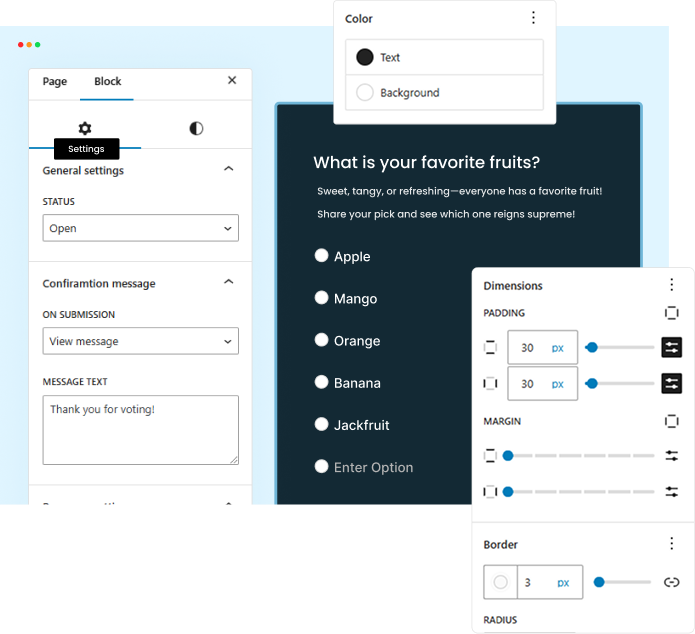
Analytics is built in, so you don’t have to wire everything to GA to get value. You’ll see vote totals, option breakdowns, locations, and trends right in the admin. Prefer deeper analysis? Export to CSV and slice it your way. Learn more about its technical strengths on the feature page, compare plans on the pricing page, or check the documentation for step-by-step guidance.
Measuring Success Across All Poll Types
Data without action is just numbers. Here’s how to measure and improve your poll performance systematically.
Universal Metrics for All Poll Types
Participation Rates: What percentage of visitors engage with each poll type? Aim for:
- Welcome polls: 15-25%
- Feedback polls: 8-15%
- Decision polls: 12-20%
- Trend polls: 20-35%
- Exit polls: 5-10%
Completion Rates: Of those who start, how many finish? Target 80%+ completion rates for well-designed polls.
Engagement Time Impact: How much do polls increase time spent on your pages? Look for 20-50% improvements in average session duration.
Conversion Correlation: Do poll participants convert at higher rates? Track conversion rates for poll participants vs. non-participants.
Poll-Specific Success Indicators
Welcome Polls:
- Segmentation accuracy: Do user behaviors match their poll responses?
- Content relevance: Are personalized recommendations being clicked?
- Return visitor rate: Do welcome poll participants return more often?
Feedback Polls:
- Implementation rate: What percentage of feedback leads to actual improvements?
- Content performance correlation: Do highly-rated articles perform better in search and social?
- User satisfaction trends: Are ratings improving over time?
Decision Polls:
- Recommendation accuracy: Do users follow through on poll-based recommendations?
- Conversion assistance: Do decision polls correlate with increased conversions?
- User journey optimization: Are poll participants taking desired next steps?
Trend Polls:
- Social amplification: How often are results shared on social media?
- Brand authority building: Are trend polls cited by other sites or influencers?
- New audience acquisition: How many new visitors come from viral poll content?
Exit Polls:
- Recovery rate: What percentage of departing visitors engage with exit polls?
- Actionable feedback ratio: How much exit poll feedback leads to site improvements?
- Re-engagement success: Do exit poll participants return or subscribe?
Optimization Based on Data
Use your poll data to continuously improve:
- A/B test different question phrasings
- Experiment with poll timing and placement
- Adjust poll frequency based on user feedback
- Refine targeting based on response patterns
- Optimize follow-up actions based on conversion data
Remember: The goal isn’t just to collect responses – it’s to use those responses to create better experiences for your visitors while achieving your business objectives.
Measure What Matters (with Pollify Plugin) and Act
Pollify’s dashboard mirrors the success metrics you care about: participation, completion, engagement time, and conversion correlation. Because everything runs inside WordPress, you can segment by page, campaign, or audience and spot patterns—like which welcome prompt boosts return visits, or which decision poll nudges people to the right plan.



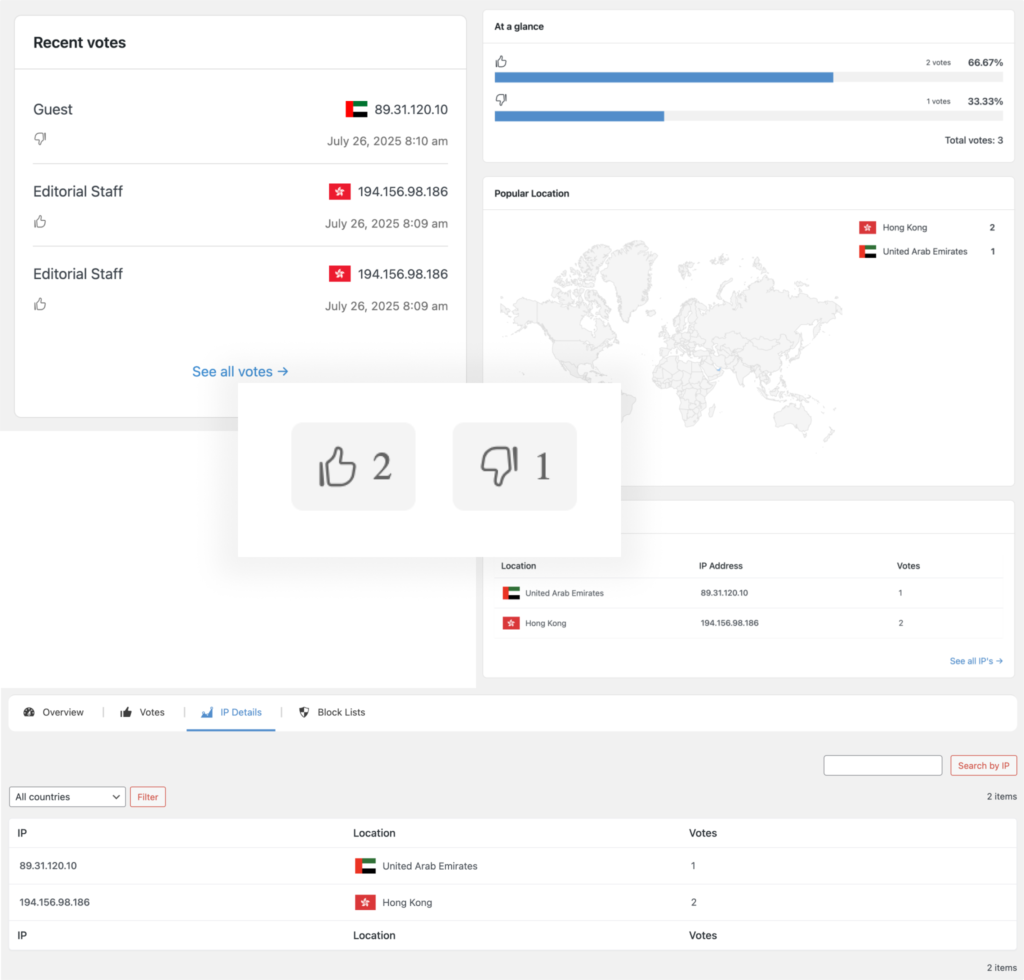
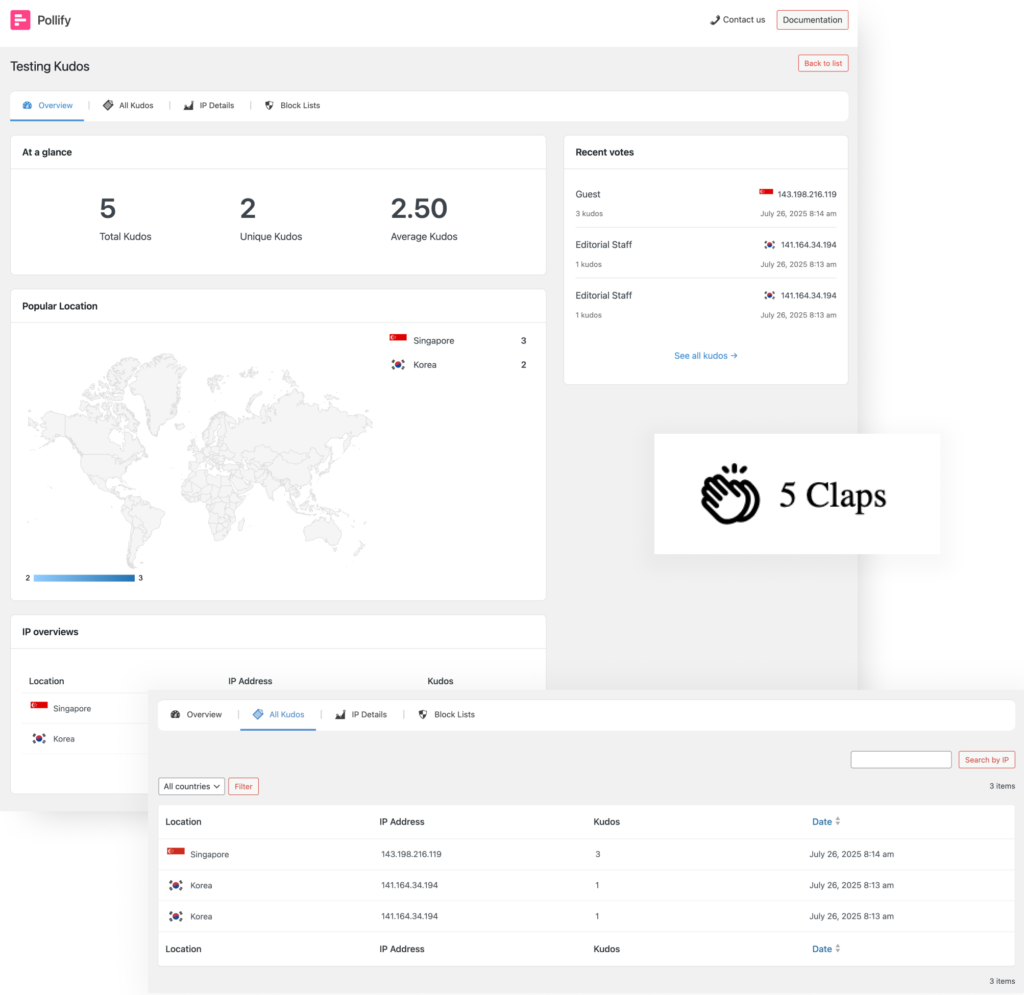
Turning data into action is where Pollify shines. Duplicate a poll to A/B test copy, reorder options to emphasize what converts, or adjust timing/placement with one click. For deeper reporting, export results and blend them with your ecommerce or CRM data. The tight loop—launch, learn, iterate—helps you hit those targets (e.g., 80%+ completion, 20–50% session time lift) faster.
Most importantly, Pollify helps close the loop between insight and improvement. Add a follow-up CTA after a vote, redirect exit-poll respondents to a rescue offer, or trigger a “thanks + next step” message. You’re not just collecting opinions—you’re guiding users and validating decisions. If you want to explore the possibilities, visit the feature page, check the pricing page, or dive into the documentation.
Common Questions About WordPress Polls
1. How do I add a poll into my WordPress site without dealing with shortcodes or external services?
Pollify offers a true Gutenberg-native Poll block, so you simply insert it like any other WordPress block—no shortcodes needed. Everything stays within your site, giving you full control and seamless integration. Learn more on the Pollify feature page.
2. Can I customize the look and feel of polls to match my theme, including fonts and colors?
Absolutely. Pollify inherits your theme’s styles by default and also offers easy customization via the block settings—color, font, borders, and alignment are all editable. You can test premium styling features on our pricing page.
3. Does Pollify support polls optimized for mobile?
Yes! Every Pollify block is fully responsive, working beautifully on desktops, tablets, and phones. You don’t need extra plugins or adjustments for mobile-friendly display.
4. How do I prevent users from seeing too many polls and causing fatigue?
Pollify includes built-in frequency controls. Set rules so visitors only see one poll per session or page, such as skipping exit polls if they’ve already completed a welcome poll. Check out the full setup guidance in our documentation.
5. Can I analyze poll results and export data for deeper insights?
Of course! Pollify has a built-in analytics dashboard showing votes, trends, and geolocation. When you’re ready to do deeper analysis, just export results as a CSV file to use in spreadsheets or BI tools.
Conclusion and Next Steps
Let’s be honest, most WordPress sites are boring. They’re digital brochures that talk at visitors instead of engaging with them.
But you’re different. You understand that those 54 seconds of average visitor attention are precious, and you’re going to make them count.
The five poll types we’ve covered aren’t just engagement gimmicks – they’re strategic tools for building relationships, collecting valuable data, and guiding visitors toward meaningful actions:
- Welcome polls segment your audience from the moment they arrive
- Feedback polls create a continuous improvement loop for your content
- Decision polls guide overwhelmed visitors while revealing their priorities
- Trend polls establish thought leadership while driving viral engagement
- Exit intent polls recover departing visitors and gather crucial insights
The strategic value goes beyond engagement metrics. You’re building a data-driven understanding of your audience that informs everything from content creation to product development to marketing messaging.
Your Next Steps
Don’t try to implement all five poll types at once. Start with the one that addresses your biggest current challenge:
- Low engagement? Start with welcome polls
- Unclear audience needs? Begin with feedback polls
- High bounce rates? Try decision polls
- Need more social sharing? Launch with trend polls
- Losing potential conversions? Implement exit intent polls
Remember: The best poll strategy is the one you actually implement and optimize based on real data. Use Pollify to make your job easier.
Ready to transform your static WordPress site into an engaging, data-driven experience?
What type of poll will you implement first? Let us know in the comments below – consider it your first poll participation!


